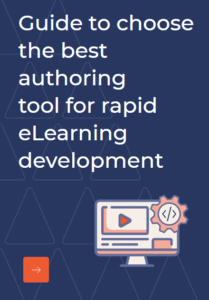How long does it take to create 1 hour of training? A question that has often been addressed yet answered subjectively, in a case-specific manner most of the time. ATD reached out to L&D practitioners to gather data over a few weeks during the summer of 2017 and came up with a few comparison charts. The data in 2017 was compared with that of 2009 and 2003 and significant changes were observed.
Though the answer still remains unclear. What we know for a fact is that a lot of effort goes behind creating eLearning courses. As written in the ATD article, “‘one hour of training is not the sole answer to our needs. But it can provide a useful tool for guiding how we manage to learn development.” And that management determines how well the eLearning is accepted and how the eLearning is utilized. Do the learners participate in the learning, how many of them actually complete the course? And if the participation is low, how do we boost eLearning usage?
While some questions will be answered by and by, here are a few tips to boost eLearning usage.
Tip 1# Know your target audience (the learners)
The biggest flaw of any eLearning strategy could be going ahead without understanding the expectations and needs of the target audience or learners. Find out the needs, the infrastructural settings, the primary learning requirements, the learning schedules, and IT proficiency levels too. You don’t want to spend time creating an extraordinary course that the learners are unable to use. This initial homework will allow creating relevance amongst the course and the learners for whom the course is created.
Tip 2# Analyze the Learning Culture
How an organization learns, has a great impact on the way learning is accepted. So, for instance in an organization with a large number of employees constantly traveling, a classroom training or blended course wouldn’t be suitable. So, know how the schedules work, what the device usage policies are, how often the learners travel, etc. to create effective learning that appeases the learners.
Tip 3# Allow Collaborative Learning
Learning as a group or sharing knowledge amongst peers is a practice that often drives learning ventures too. The eLearning usage can be greatly influenced by creating a collaborative learning environment where learners learn from each other, suggestions and encouragements drive them towards eLearning. This day the social learning is one of the most preferred ways of learning (Learn, Coach and Share), especially amongst the millennials.
Tip 4# Choose the Right Courses
The eLearning content plays an important role in usage. Boring, mundane courses may be one reason that leads to lesser adoption of eLearning within the organization. To avoid this, select innovative, interesting courses (if opting for off-the-shelf courses) or create engaging eLearning content (in-house or with the help of eLearning vendors). The relevance of the course helps in increasing the better adoption of the courses.
Tip 5# Market the Learning Programme
Most eLearning strategies tend to fail because the learners aren’t informed about their benefits. While overselling may not be right, but the right amount of in-house marketing can boost eLearning usage. Also, newer concepts like gamification dashboard, reward points, etc can be used as tools to promote any eLearning in-house. Better marketing of the courses by L&D in-house does help to create some more hype amongst the users.
Tip 6# Keep Channels Open for Feedbacks
eLearning is not a one-way channel; its scope of improvement acceptance etc. often increases with the freedom and flexibility it offers. Let the learners learn on their own accord and let them share their opinions and feedbacks. Knowing that their opinion matters is one way to push learning too. Feedback sharing always keeps the learner engaged with the courses.
Tip 7# Provide Access to Additional Learning
Adding to the aspect of flexibility, the learning system should not restrict learning. Allow the learners to access additional learning content that may be related to the topic. This makes learning more holistic and hence, self-paced and self-exploratory too.
At the end of the day, eLearning is all about rendering the learning content in the best way possible so that it connects with the learners. This is why the process of content curation, design, and development is crucial. eLearning vendors with good experience can lighten your load and assist in this. So, if you are looking to create engaging eLearning courses, or need assistance in boosting eLearning usage, just drop us a message at info@www.knowzies.com.



